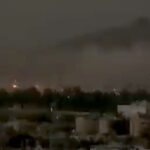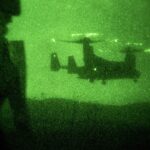The United States conducted a counterterrorism operation in Yemen that eliminated Qasim al-Raymi, the leader of al-Qa’ida in the Arabian Peninsula (AQAP) and a deputy to al-Qa’ida leader Ayman al-Zawahiri. The operation took place on January 29, 2020, as a kinetic strike, but al-Raymi’s death was only confirmed on February 7, 2020. His death further degrades AQAP, the global al-Qa’ida (AQ) movement and their ability to stage external attacks.
T-Intelligence has reported about the growing U.S. counterterrorism mission in Yemen since 2018, when we exclusively presented an airfield near Mukalla used by the Central Intelligence Agency (CIA) and Joint Special Operations Command (JSOC) to eliminate AQAP targets, including Qasim al-Raymi. You can find that assessment here.
Qasim al-Raymi is the latest foreign terrorist leader and high-value target (HVT) to be neutralized by the U.S in the past year. JSOC and CIA killed several Tanzeem Hurras al-Din (THD) and Hay’at Tahrir al-Sham (HTS) militants in Idlib province (Syria) throughout 2018 and 2019. The 1st Special Forces Operational Detachment Delta (or “Delta Force”) neutralized ISIS leader Abu Bakr al-Baghdadi in a direct action raid on his compound in Barisha (Idlib) in late 2019. A U.S. MQ-9 Reaper drone killed IRGC-Quds Force Major-General Qassim Soleimani near Baghdad International Airport on January 3, 2020.
High-value targeting (HVT) operations aim to throw organizations in disarray by “beheading” leadership figures and therefore complicating ongoing or planned operations. In the case of highly personalized groups, HVT campaigns can demoralize their supporters. HVT campaigns should not be viewed as a solution to a problem, but as an instrument of pressure that is highly efficient in the short-term.
HVT- QASIM AL-RAYMI
- Born and raised in Yemen, Qasim al-Raymi was a veteran of the Soviet war in Afghanistan, where he fought and trained alongside AQ central headed by Usama Bin Laden.
- Returned in the Arabian peninsula, Raymi became a major jihadi figure in southern Yemen, orchestrating attacks and seizing territories. In 2005, Raymi was imprisoned on terror charges.
- A year later, Raymi and other 22 AQ-affiliated figures broke out of prison and worked towards creating AQAP.
- Al-Raymi became the group’s top emir in June 2015, after Abu Basser al-Wuhayshi was killed in a U.S. kinetic strike. Under his leadership, AQAP reached an apogee of territorial expansion, which included Yemen’s fifth-largest city, al-Mukalla in 2015. The seizure or urban locations enabled AQAP to impose ISIS-style governance over large populations.
- AQAP was only forced out of Mukalla in April 2016, when the Arab Coalition-backed by U.S. air power launched an offensive to recover the city. Since then, al-Raymi has been the target of an aggressive U.S. SOF campaign.
- In January 2017, the U.S. Naval Special Warfare Development Group (DEVGRU, or “ SEAL Team Six”) launched a direct action operation on the village of Yalka to capture or kill Raymi. While the target was not found, the operation was a major success in terms of intelligence collected.

Qasim al-Raymi in a 2017 video via The Long War Journal
THE AQAP TERRORIST THREAT
AQAP is a foreign terrorist group and one of the strongest AQ affiliates worldwide. The group was formed in 2009 from the merger of AQ’s cells in the Kingdom of Saudi Arabia (KSA) and Yemen. As a militant jihadi group, AQAP plans to purge the Arabian peninsula of “Christians and Jews” and establish an Islamic Caliphate. AQAP’s strategy includes disbanding the Yemeni state, overthrowing the Saudi royal family, assassinating Western nationals and striking Western targets at home and abroad. The terror group has been actively plotting and executing both internal and external attacks intended to cause mass casualties. The group’s most infamous attacks include:
- October 12, 2000: a water-borne improvised explosive device manned by two AQ operatives rams into the USS Cole in the Port of Aden, killing 13 U.S. service members.
- December 6, 2004: A group of AQAP gunmen attacks the U.S. Consulate in Jeddah, KSA, killing 5 non-American staff members.
- September 17, 2018: AQAP militants detonate two vehicle-borne improvised explosive devices (VBIEDs) outside the U.S. Embassy in Sana’a.
- August 27, 2009: AQ militant Abdullah Asiri attempts to assassinate KSA’s Prince Mohammed bin Nayef, then Assistant Minister of Interior for Security Affairs, by detonating an explosive belt. Bin Nayef was only injured.
- December 6, 2013: AQAP ram a VBIED into attack into a hospital of the Yemeni Defense Ministry in Sana’a and then storm the building with assault rifles. The attack left over 50 people dead.
- January 7, 2015: Said and Cherif Kouachi attack the office on the satirical magazine Charlie Hebdo in Paris, killing at least 12 people. The Kouchi brothers received firearms training in Yemen and were acting on behalf of AQAP.
- December 6, 2019: A Saudi airman opens fire on a classroom building at the Naval Air Station in Pensacola, U.S, killing three people.
COVER PHOTO: As seen through a night-vision device, U.S. coalition forces and Afghan commandos get dropped off at their target by a U.S. Army CH-47 Chinook helicopter to conduct a night operation in the Sairobi district of Afghanistan’s Kabul province, Dec. 2, 2013. (U.S. Department of Defense)
- Russia Bombs Maternity Ward & Children’s Hospital in Mariupol As Part of Siege - 10 March 2022
- T-Intell’s OSINT Training Marks One Year Anniversary - 18 November 2021
- IS-K Never Left the Battlefield - 27 August 2021





